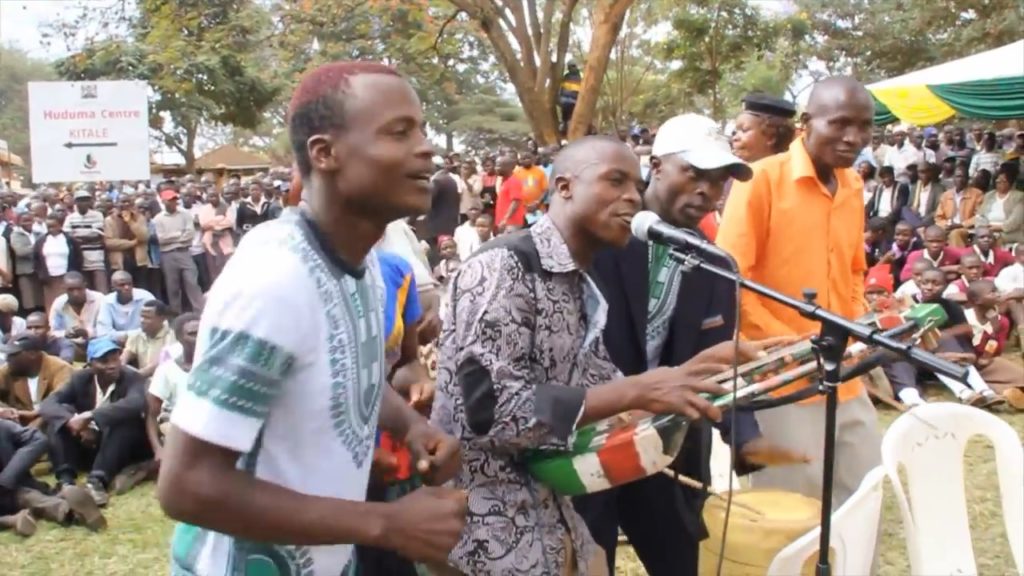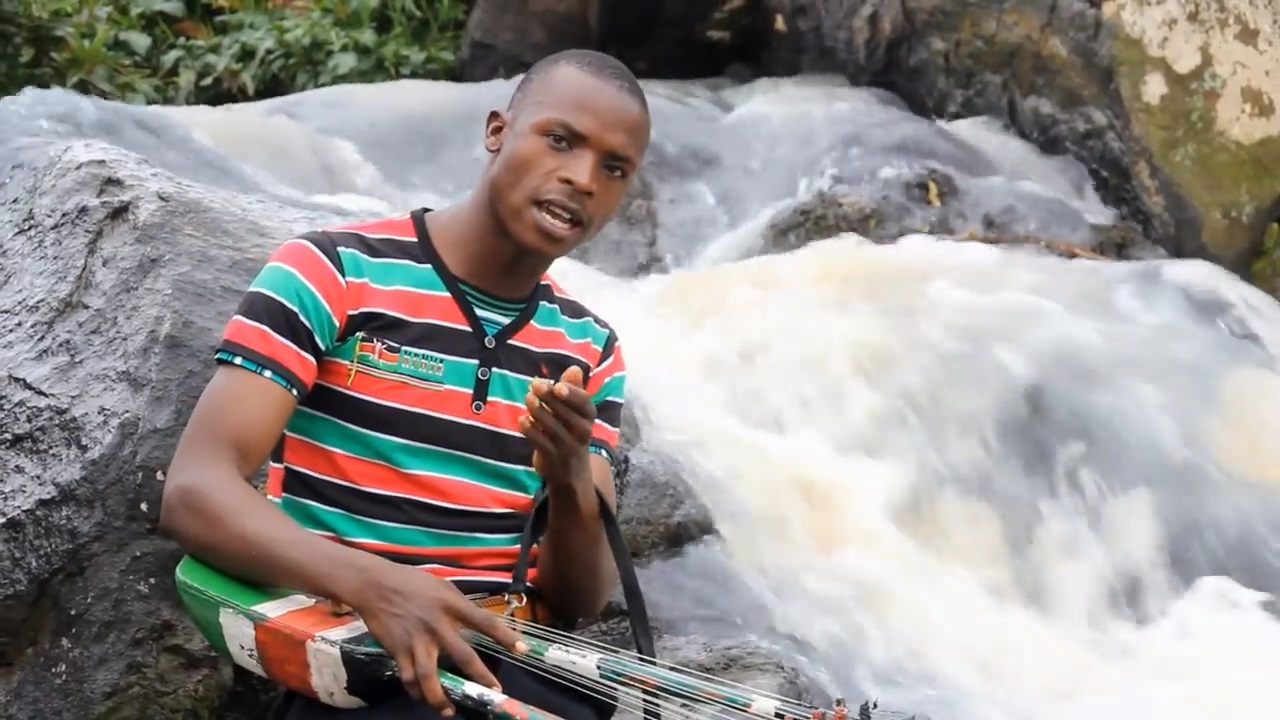Bindu Bichenjanga by Amos Barasa is contemporary Bukusu pop music. Barasa is a young man, probably not yet thirty, who represents a breed of new age Kenyan musicians comfortable singing in vernacular.
He’s the first among equals, of hopefully many to come, talented generation of Luhya entertainers. Budding maestros who similar to their contemporarraries in Kapuka (AfroPop if you like) are brave in their sound. Budding maestros revolutionizing vernacular Luhya music by infusing hip hop, house, calypso and even rumba sounds. That Amos Barasa who begun his signing career in high school, sold out by his Swahilinized Lubukusu, hails from Kimilli, Kamukuywa or Tongaren is a smart guess.
Anywhere really, where the W’Amutala – the speakers of this dialect of Lubukusu – hail from. When compared to his peer Steve Kay – who in Mbe’ Omukhasi had to layer Swahili and English to up the crossover appeal of his run away hit – Barasa’s native speak of Lubukusu in Bindu Bichenjanga, does the trick.
Bindu Bichenjanga: The magic of a crossover hit
How did a song sang entirely in vernacular entice and enchant a nation of 43 tribes replete with hundreds of dialects? Further down, the differences between Luhya dialects are often exaggerated. Truth is, any Luhya who knows his mother tongue well, will comprehend his Mulembe brother. Nonetheless, the effect of how Amos Barasa speaks Lubukusu – akin to how Gideon Moi speaks Swahili – can’t be underestimated. By riding on the swahilinization of Kenyans through the school system, Bindu Bichenjanga attained mass appeal.
At the go, Bindu Bichenjanga hits the listener with a burst of melody. All thanks to the familiar sound of an expertly strung, excellently strummed Litungu. This string instrument is quintessential to Bukusu folk music. It is the star of a cast of musical instruments that on evidence of public performances of the hit, includes less sophisticated pieces like repurposed 20 liter plastic jerricans.
Sifwototo
Wait a minute. Did someone say sifwototo ? Sifwototo is a flute like sound produced when air is blown through a cleft that leads into a chamber that is formed wen someone clasps their hands together such that both thumbs are upright and approximated. A sound whose pitch is varied by alternate rhythmic sweep movements of fingers, much like the manner in which one plays a wind instrument?
Well, I’m not certain about the sifwototo, in Bindu Bichenjanga. But the characteristic high tone of sifwototo punctuates the full length of this pop hit, serving to stir nostalgia of Bukusu music of days gone by.
The politics of bindu bichenjanga
For this one, we’ll have to indulge in unwarranted pitting of amwavo against each other. Beef between the fans of our brothers though contrary to the spirit of Mulembe Nation, is necessary. The following comparison exercise is undertaken done so as to decipher the matter at hand.
A pop song is as good as it is an annotation of its time. In deed, the word pop and politics share ancestry. Though seemingly worlds apart, both words intimate the here and now. Therefore, though similar in genre, but differing in theme, Amos Barasa’s Bindu Bichenjanga and Steve Kay’s Mbe Omukhasi compete for attention in the same spaces.
More so because most have erroneously taken Bindu Bichenjanga’s popularity to stem from it being a political song. As we shall see, that’s far from it. To aid our digest of these Bukusu pop music hits, consider the two songs as potential dates. Lets call the dates Selina and Serah.
The politics of bindu bichenjanga as told through a dating analogy
Sarah is young and attractive. She’s been raised and schooled in peri-urban settings. Turned out to be a no frills, down-for-whatever kind of a girl. Sarah finds the perennially crowded Pirates beach in Mombasa much more fun than the lonely white sands of Kwale county. To get to Mombasa, for Sarah, a trip on the SGR would be such an adventure. For Christmas, all Sarah wants is a goat to slaughter and the uneasy laughter of family at shags.
Selina ( also young attractive) is a city girl. She has been to Mombasa and hates Pirates beach. Selina contends that public beaches doesn’t allow for sufficient lovey-dovey time. Adventure for her is Diani by air. Snorkeling at Kisite-Mpunguti National reserve, while a wine tasting excursion down south is her preferred Christmas.
Pose for a moment and consider who you’d date. Consider also who you’d marry. While the answers to these two questions are sure to vary, the answer to who of Selina or Serah matches the profile of kin, kith and kindred is likely less volatile.
Bindu Bichenjanga is Sarah in our analogy. It is the people’s song, that annotates our lived experiences. Its Riverwood style only serves to fortify this perception. Conversely, Mbe Omukhasi, our Selina, annotates our aspiration as a people.
In this regard, Bindu Bichenjanga is you and me. Here and now together with our kin and kindred. Mbe Omukhasi on the other hand is our tomorrow. But our dreams of tomorrow are intimate and personal. Not even a mother knows the in and outs of his child’s dreams neither does a husband know the secrets of his wife’s desires.
To Nafula, Muhonja, Wanjiku, Chebet, Akati and Wandera – from this standpoint of the future and the now – it’s easy to see why Bindu Bichenjanga pips Mbe Omukhasi as the Luhya pop song of the moment. There is a reason for this.
Steve Kay & Amos Barasa are at Different Stages of their Careers
You have to admire the courage of Steve Kay in Mbe Omukhasi. Here, Steve Kay elevates Luhya vernacular pop music across the borders. His audacity in showing us tomorrow is nothing short of admirable. He is at that stage of his career where he has to elevate his brand and become an ambassador, sort of, of the Mulembe Nation.
Similarly, Amos Barasa stakes his claim as Mulembe Nation co-ambassador by remaining true to a maxim of Mulembe Nation’s worldview: simplicity, a treasured mien among the luhya.

Amos Barasa performing Bindu Bichenjanga live in Kitale. Barasa tickles the Litungu while a band member cajoles the improvised drum. Image|Amos Barasa
His simplicity appears circumstantial. Amos is not a brand as big as Steve Kay. But by being himself, keeping it simple, Amos Barasa scores huge points with the masses. Kenya being a largely rural to Peri-urban country, Amos Barasa quickly touches base with his core fan base, before going for the hearts of Kenyans. Bindu Bichenjanga proves that there is truth in the maxim: simplicity is a prerequisite for magnificence.
Why Jubilee Missed The Bus With Bindu Bichenjanga
First, Bindu Bichenjanga is a simple sing along familiar tune that fits perfectly into political rhetoric. Kind of in the manner of the late Otieno Kajwang’s Bado Mapambano refrian. Secondly, Bindu Bichenjanga is unwittingly a jubilee government scorecard. Sort of actually but it’s easy to see how a master crowd mover like Kubende can mold it into one if he put his mind to it.
Bindu Bichenjanga highlights successful government projects. The message is clear and precise fronting contemporary themes like: devolution, accountability, youth leadership, digital migration, digital learning program etc.
Amos takes us through the journey of Kenya’s transformation in the last 5 years. At some point in the video, probably a symbolism of renewal, the viewer sees analogue television sets getting washed away in a swollen river. Having being released in n election year whose campaigns were heavy on Biblical inferences, we’ve got to speculate on the symbolism here.

The strong message of change in Bindu Bichenjanga is fortified by symbolism in the music video
BEYOND POLITICS: Bindu Bichenjanga Honours Bukusu Culture
Amos Barasa subtly incorporated Bukusu culture in making the video to Bindu Bichenjanga. On many occasions he sings/dances by a water fall, river bed and even right in the middle of the river. Among the Bukusu, the river is a holy and sanctified place. Alms and offerings are presented to the gods here. Water was seen as a cleansing agent. The flow of the river, together with this cultural reference to cleansing reaffirms the song’s key theme: change.
BINDU BICHENJANGA: A Powerful Social Message of Humility and Love
A message of love, humility, hope and economic empowerment, dare I say of the Spirit of Mulembe, dominates Bindu Bichenjanaga. Amos Barasa urges the endowed and powerful in society to help and serve the poor. The choice of the word Bamanani (the poorest of the poor) is deliberate.
This is the same powerful message that Amos passes on to leaders who promise heaven when looking for votes then fail to deliver. Barasa urges listeners to love one another and asks the people of Mulembe to carry themselves with humility in order to prosper. Being a proper Bukusu, Barasa doesn’t fail to end the song by sending greetings recognizing his family, politicians and academicians.
Listening to Bindu Bichenjaga makes one want to rise from his seat and shake a leg. This one is sure to make one hit the dance floor leaving their drink unattended from beginning to the end. Overall, the song gets a 8.5/10.
Subscribe to Mulembe Weekly
Get culture, language, stories and discussions in your inbox every Friday 5 PM East Africa Time

